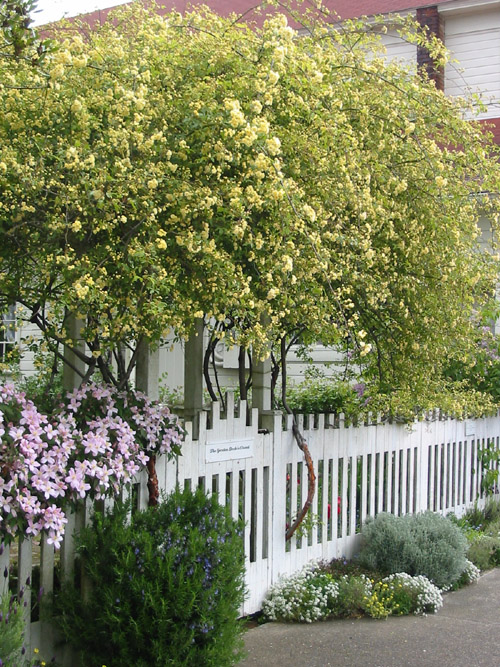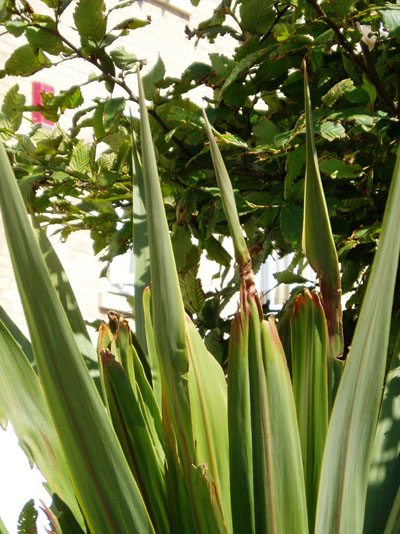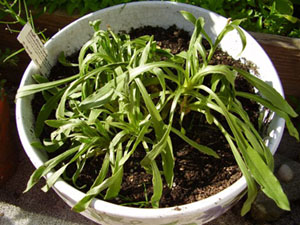Picture questions answered by Tracy Wilson
 Corylopsis in front of fence
Corylopsis in front of fence
From a reader in Oregon, USA
Q. I live on the Oregon coast, about three miles from the ocean. We have strong north winds in the summer. My garden is bounded on the east by a two story building, on the north by a six foot fence, on the east by another one story building and some Hydrangea, Birch trees and Myrtle, a Spruce. And the south is a picket fence with gate. last spring I planted a three foot diameter Winter Hazel (Corylopsis) in front of the north fence, where most of the sun is during mid day. When the wind really blows, it tends to eddy around in the garden and there isn't much protection anywhere. I am contemplating moving the Corylopsis near to the south gate, between the Hydrangea and under Birch trees. It will get less sun. I'm unsure whether transplanting would be a good thing for it. It feels like a more protected place but it probably will get some wind there, too. and I'm not sure when is the right time to transplant. It is very cold these days, and I wonder whether transplanting during cold weather is good for the roots. Any advice? Thanks so much.A. You sound as though you have an interesting garden and are not afraid to try some different plants. However, in the case of your Corylopsis, you have chosen a slightly tricky subject. It will certainly resent being moved in the depths of your cold weather and I would recommend waiting until you get a mild period during the winter to move it. However, in the mean time it would probably be a good idea to root prune it in preparation for the move. Go around the plant, just inside the canopy edge of the plant itself, with a spade and cut straight down. Do nothing else but this will sever the roots ready for the move. Corylopsis prefer a more sheltered site, semi shade is fine but they enjoy a hot autumn to ripen the wood and ensure a good flower display. If the weather hasnít offered a suitable window before it flowers, donít think that you have missed the boat. As long as it has not come into leaf it can still be moved. I hope this helps.
 Phormium with damaged leaves
Phormium with damaged leaves
From a reader in Portsmouth, UK
Q. The plant is a Phormium and lives, with us about 75m from the sea in upper Portsmouth harbour. It's about 4 years old, in full sun in the morning and shady during the afternoon. Earlier this year I did put horse manure around the base. I haven't seen any beasties on it but I have seen some small black bugs squareish in shape and about 1cm on the laurels next to it. This is the first year this has happened.A. Your Phormium is now showing the results of damage done earlier in the year. Looking at it, I would say that it was likely to be frost damage, unless you have an extremely mild garden. It could equally easily be physical damage from the wind, a falling branch or an outside chance of slug damage. Either way, the damage occurred in the stage when the leaves that are now showing were in the centre of the plant, as a central spear. Unfortunately there is nothing you can do to remedy the problem, and I would recommend cutting off the affected leaves.
 Dimorphotheca wilting
Dimorphotheca wilting
From a reader in Vancouver, Canada
Q. Could someone possibly help me with my Dimorphotheca barberae? (known as Osteospermum barberae in the UK). I've had it for about a month. It was blooming when I got it, I planted it in a large container after the last bloom had finished—well-drained soil and pot. It's been getting full sun and I was concerned because it seemed to have stopped blooming after the original flowers were gone. This week I found a large bud on it, and was delighted. But yesterday I found the whole plant wilting. I poked in the soil and found it somewhat dry (but not bone-dry), so I gave it good dose of water. Today it's still badly wilted, so I took it out of the pot and examined the root ball. Looks fine. The only notable thing was an earthworm in the pot, but surely he's not doing any harm. I've repotted it and put it out of the sun for the time being. *Dimorphotheca is also known as Osteospermum. A. It looks to me from your photographs as if it has been over-potted and over-watered. Looking at it, I think the answer is that it has been put into quite a big pot, quite early on. Despite the fact that you’ve had it on a sunny, warm patio, I think it’s just gone into too big a pot too quickly. Sometimes (not always) they can go downhill when that happens. The way it’s collapsed strikes me that the problem is at the root. If I were you I would knock it out of the pot and go down a size in pot – ‘unpot’ it, I suppose, rather than ‘repot’ it! Put it into a light multi-purpose compost, make sure it’s got very good drainage, keep it out in the sun again and don’t overwater it. You could use a John Innes compost. Make sure that the bottom of the pot has got crocks in it, it should then be fine so long as it’s got good drainage which is a key thing. And basically, cross everything...!
